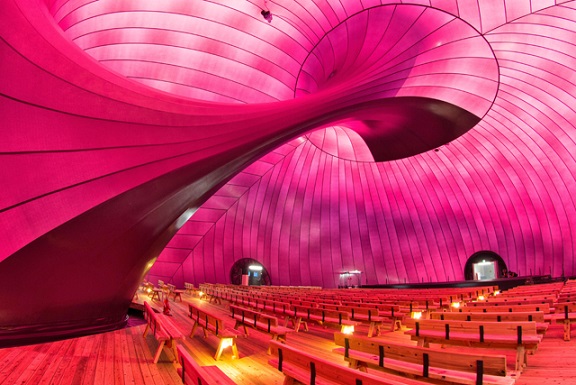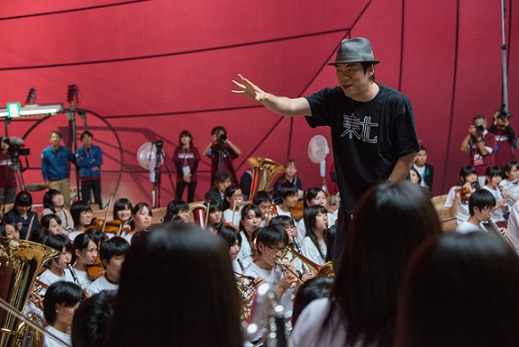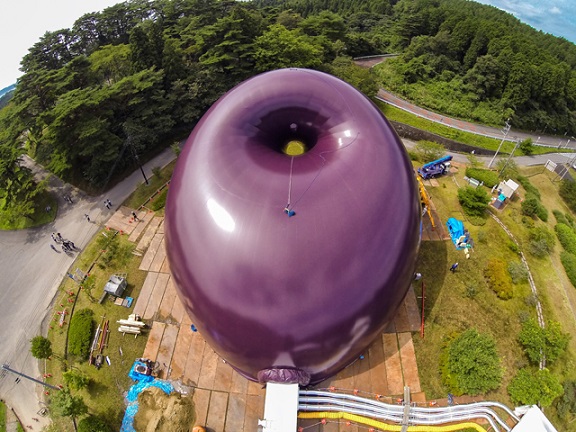藝評
Culture in Motion - A mobile, inflatable auditorium brings arts programming to a tsunami-devastated region of Japan
Leon TAN
at 5:24pm on 16th September 2014





Captions:
1. Ark Nova, designed by artist Anish Kapoor and architect Arata Isozaki, was installed in Matsushima, Japan. Photo © 2013 Lucerne Festival Ark Nova.
2. Ground crew prepares Ark Nova for inflation. Photo © 2013 Lucerne Festival Ark Nova.
3. Inside Ark Nova. Photo © 2013 Lucerne Festival Ark Nova.
4. Musician Otomo Yoshihide. During rehearsals inside Ark Nova, musician Otomo Yoshihide holds a workshop with the Tohoku Youth Orchestra. Photo © 2013 Lucerne Festival Ark Nova.
5. Tohoku Youth Orchestra. Gustavo Dudamel conducts the Tohoku Youth Orchestra inside Ark Nova. Photo © 2013 Lucerne Festival Ark Nova.
(原文以英文發表,評論日本松島琉森音樂節的「Ark Nova」計劃。)
On March 11, 2011, a magnitude-9 earthquake, one of the most powerful in recorded history, hit Japan, and was followed by a devastating tsunami. The catastrophe claimed more than 18,000 lives and left vast swathes of the northeast severely damaged if not destroyed. In the Tohoku region, whole towns were swept away; the force of the quake even moved Honshu Island nearly eight feet eastward. To make matters worse, the tsunami also led to system failures at the Fukushima Daiichi nuclear power plant, resulting in the release of massive amounts of radioactive material. More than 160,000 residents were forcibly displaced from their homes due to the danger of radiation poisoning.
Ark Nova is an ambitious project initiated by Michael Haefliger of the Lucerne Festival (a Swiss international music festival founded in 1938) as a gesture of compassion for, and solidarity with, the survivors of this disaster. Conceived as a mobile, inflatable auditorium with a 500-person capacity, it brings music and art to the Tohoku region with the hope of healing psychosocial traumas. According to the organizers, Ark Nova, meaning new ark, takes inspiration from the biblical narrative of the great flood and Noah’s ark.
The ark is also inspired by the ancient Japanese notion of marebito—“sacred guests” who arrived from foreign lands with special religions or festivals that rejuvenate society. Like the mythical Noah’s ark, Ark Nova is intended as a symbol of renewal and recovery after a tremendous disaster. It is a visitor bringing those vital elements out of which culture is periodically composed and recomposed—namely, music, dance, improvisation, and ritual interaction.
The mobile architecture results from the collaboration between the Indian-born British artist Anish Kapoor and the Japanese architect Arata Isozaki. Kapoor is renowned for large-scale abstract sculptures such as Cloud Gate in Chicago’s Millennium Park and Sky Mirror in Nottingham, England. Isozaki is perhaps most famous for the Los Angeles Museum of Contemporary Art, the Team Disney Building in Florida, and, most recently, the Qatar National Library.
Their concert hall consists of an inflatable membrane modeled after Kapoor’s Leviathan installation inside Paris’s Grand Palais in 2011. The structure is about 120 feet long and is made of PVC-coated polyester. It comes fully equipped with stage and sound rigs. The entire hall and its equipment pack down into a truck, making it easily transportable.
Unlike Leviathan, which was created for the interior of a building, Ark Nova is itself an interior, a continuous space that can accommodate a diverse range of cultural events and a variety of equipment and arrangements. Visually, the abstract form of the structure is reminiscent of an eggplant or body organ, and its smooth curves recall organic processes of folding, such as embryogenesis.
The realization of the project from its conception in 2011 took two years. In the first installment of Ark Nova, the concert hall was erected in Matsushima City in the Miyagi Prefecture (part of the devastated Tohoku region) between September 27 and October 13, 2013. The inaugural festival featured performances by acclaimed musicians and conductors such as Ryuichi Sakamoto and Gustavo Gimeno, a street jazz festival, and Japanese dance and kabuki performances by Tojuro Sakata, Kichizoh Wakayagi, Kikunojo Onoe, and Motoi Hanayagi.
In keeping with the project goal of revitalizing culture, organizers also established the Tohoku Youth Orchestra, drawing on thetalents of more than 280 local children chosen by teachers from schools across the region to produce public performances, as well as workshops with Ryuichi Sakamoto, Yoshihide Otomo, and Gustavo Dudamel. Sakamoto himself believes that this engagement with music can assist in the healing of traumas, an idea that is borne out by the literature on expressive and music therapies.
THE POWER TO HEAL?
Almost three years after the quake and tsunami, thousands are still officially missing and thousands more living in temporary shelters. Even though much of the physical debris has been cleaned up, the invisible psychological trauma of such upheavals is likely to persist, and the suicide rate remains high. While undoubtedly innovative (it is the first inflatable concert hall in the world), Ark Nova has also been viewed with skepticism. What could “high art” possibly do amid the more pressing concerns of basic survival and recovery of livelihoods?
In attempting to evaluate the cultural significance of Ark Nova, we can take a cue from how Anish Kapoor understands art. Kapoor has said that “artists don’t make objects. Artists use objects to make mythological events.” Ark Nova then is first and foremost a vehicle for resurrecting the mythological in the midst of preoccupations with realistic or pragmatic concerns. In other words, Ark Nova creates encounters for its audiences with other mysterious—or even spiritual—worlds.
This interpretation is consistent with the notion of the marebito, which the folklorist Shinobu Orikuchi explains is a visitor not only from foreign lands, but also from tokoyo no kuni: the outer, or everlasting world. In Japanese folklore, these rare guests from the everlasting world visited villages on special occasions such as the construction of new buildings or the new year and autumn harvest festivals. Their presence was believed to join the visible and invisible worlds, transmitting blessings from the latter to the former. Ark Nova’s programming of music and dance, like the marebito, brings the visible world of people together with the invisible world of personal and cultural memory, by immersing them in experiences that are by turn contemplative and improvisational.
These experiences should not be underestimated, even if they contribute nothing directly to “concrete” rebuilding and recovery efforts. For one thing, they provide respite from pragmatic concerns, many of which are intertwined with posttraumatic stress responses such as hypervigilance, emotional numbing, or intrusive recollections of the event. Whatever the symptoms, the aftereffects of trauma tend to follow a repetitive logic. Without intervention, many spend the rest of their lives bound in habitual, life-negating patterns of thought, feeling, and action. Reflective and improvisational encounters within the womblike membrane of Ark Nova interrupt this repetition—and may even diminish post-traumatic stress and open up new ways of living with the past and present.
Kapoor also says that the organic forms he prefers are designed to evoke a “primordial” memory of human forms. For Kapoor, the mythological is also the primordial: the images, energies, and emotional intensities of our collective human unconscious or deep past. He believes that color, and monochrome in particular, has a special propensity to facilitate primordial human recall. For those who have become emotionally numb in the aftermath of personal and collective trauma, then, the red glow of sunlight filtering through the purple membrane of the concert hall may be especially revitalizing.
THE FUTURE OF ARK NOVA
One of the challenges that socially ameliorative public art projects face is that of effecting lasting change. In Ark Nova’s case, after just one installment it is too early to evaluate its success or failure. In the meantime, one indicator may be to see whether or not the Tohoku Youth Orchestra, formed during the festival in 2013, survives beyond its initial performances.
There are currently no firm plans for the next installment of Ark Nova. The original idea, though, is for the ark to tour several of the affected areas. Perhaps the first edition will serve as a model for an annual or biennial Ark Nova festival in the coming years. Perhaps it can also serve as a new model for arts and cultural institutions. Similar projects include Marysia Lewandowska’s Open Cinema, a temporary public movie theater that first opened in Portugal, as well as Rachel Tess’s Souvenir, a mobile theatre/performance space based out of New York City. Such projects encourage us to consider mobile platforms and temporary infrastructures as an alternative to permanent museum buildings and concert halls. It’s worth asking if such initiatives could improve accessibility to art and culture, particularly in “peripheral” regions and communities.

Ark Nova. When inflated, Ark Nova can hold 500 people. So far, it has been installed only once. Photo © 2013 Lucerne Festival Ark Nova.
This article was first published in Public Art Review, Issue 50, June 2014.
